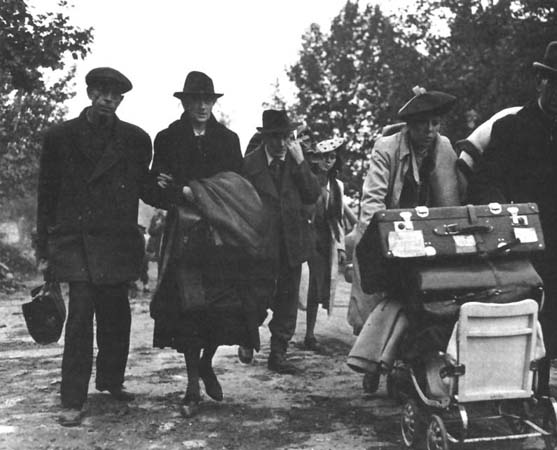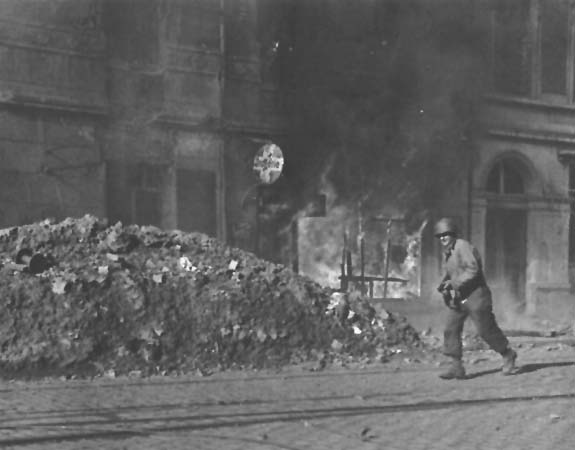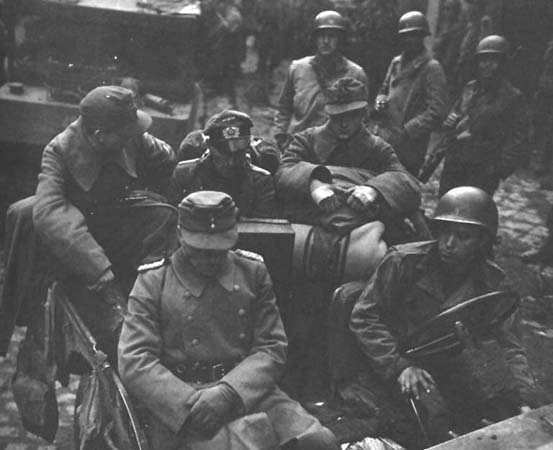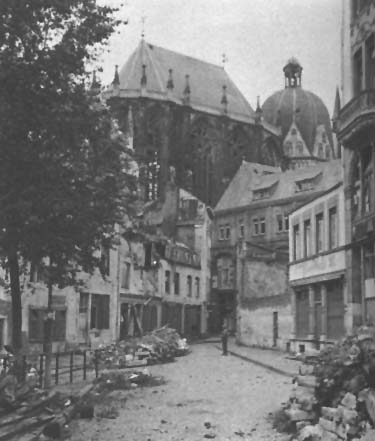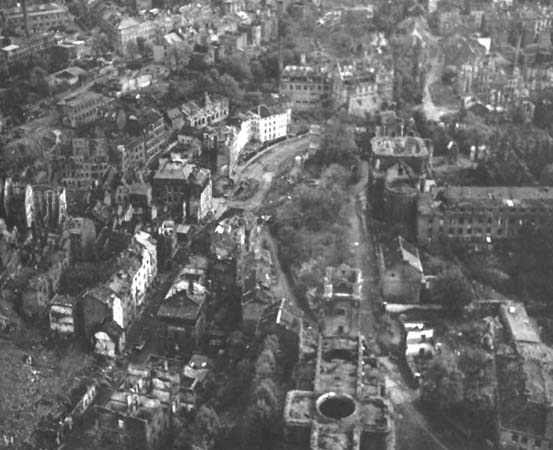CHAPTER XIII
Assault on the City
When the Aachen encirclement maneuver began on 8 October, the city that was the ultimate objective was already a scarred shell. Less than 20,000 of Aachen’s prewar population of some 165,000 had clung to their homes through the various vicissitudes of Nazi evacuation orders. As early as two months before D-Day in Normandy, the British had bombed the city; in late May British planes had struck again and again for three days at what was left. By 8 October much of Aachen already was a sterile sea of rubble. Long before American tanks first had poked their snouts over nearby hills in mid-September, Aachen had learned what war is like.1
Few in Aachen could have doubted that the end was near when on 10 October three Americans—1st Lt. Cedric A. Lafley, 1st Lt. William Boehme, and Pfc. Ken Kading—approached along the Trierer Strasse bearing a white flag and a surrender ultimatum. As most were to learn from listening to Radio Luxembourg or to American public address systems, or else from examining leaflets which American artillery shot into the ruins, the Americans were granting the commander of the Aachen military garrison twenty-four hours in which to surrender.
The city of Aachen [the ultimatum stated in part] is now completely surrounded by American forces . . . . If the city is not promptly and completely surrendered unconditionally, the American Army Ground and Air Forces will proceed ruthlessly with air and artillery bombardment to reduce it to submission.2
The military commander of Aachen at the time of delivery of the surrender ultimatum was Colonel Leyherr, one of the 246th Division’s regimental commanders. Colonel Leyherr dutifully rejected the ultimatum in accord with "last stand"’ orders that had come from the Jovian pen of Hitler himself.
Two days later Colonel Leyherr was relieved in deference to the arrival of his division commander, Colonel Wilck (246th Division). Colonel Wilck established his headquarters in the Palast-Hotel Quellenhof, a luxurious Kurhotel in Farwick Park in the northern portion of the city. (See Map 4.)
For bringing Aachen to heel, the attack force available to General Huebner, the American commander, was numerically inferior to that Colonel Wilck had for defense. Forced to dispose the bulk of the 1st Division elsewhere on an elongated front and to husband one infantry battalion as a reserve, General Huebner had but two battalions of the 26th Infantry
[307]
CIVILIAN REFUGEES LEAVE AACHEN
free to assault the city. Within the inner defenses of Aachen, Colonel Wilck had roughly 5,000 men. Most were from Wilck’s own 246th Division, though some represented nondescript fortress units and 125 were Aachen policemen thrust into the line under command of the chief of police. Some eighty policemen from Cologne were later to slip through the gap at Wuerselen to join the fight.
As Colonel Wilck must have known, the great American superiority was in armor, artillery, and planes. Although the Luftwaffe had begun to display recognition that a war still went on in the West, the German planes usually appeared only in small groups and at night when Allied aircraft were not around. As for armor, Colonel Wilck had no more than about five Mark IV tanks. As long as communications remained constant, Colonel Wilck might solicit substantial artillery support from outside the city; but at hand within the inner defenses were only 19 105-mm. howitzers, 8 75-mm- pieces, and 6 150-mm. guns.
On the American side, General Huebner naturally desired quick reduction of Aachen, yet he saw no point in a Pyrrhic victory. Even had he desired a bold
[308]
During the two days when the 18th Infantry was driving north through Verlautenheide to Ravels Hill, the 26th Infantry had been eating away at Aachen’s eastern suburb of Rothe Erde and otherwise getting into position for assault on the city. To reduce his frontage, Colonel Seitz put a provisional company into the line on his left wing to face Aachen from the southeast. This company tied in with defenses of the 1106th Engineers south of the city. Although the engineers were to pivot their right wing from time to time in order to maintain contact as the 26th Infantry advanced into the city, they were not equipped to make a full-blooded attack.
Colonel Seitz pressed his 2d Battalion under Lt. Col. Derrill M. Daniel up to the Aachen-Cologne railroad tracks at Rothe Erde and prepared to send the battalion westward through the heart of Aachen. His remaining battalion, the 3d, under Lt. Col. John T. Corley, moved to jump-off positions north of Rothe Erde (between Rothe Erde and Haaren). From there Colonel Corley was to strike northwestward against a wilderness of factories lying between Aachen proper and Haaren and thence westward to seize three hills that dominate Aachen from the city’s northern fringes.
The bulk of this hill mass, developed as a big public park, is known as the Lousberg. It rises to a height of 862 feet and casts a shadow over almost the entire city. The Americans were to know it as Observatory Hill after an observation tower on the crest. A lower knob on the southeastern slopes of the hill, crowned by a cathedral, is known as the Salvatorberg. Farther down the southeastern slopes in Farwick Park stands the elaborate Palast-Hotel Quellenhof and a municipal Kurhaus where, in happier days, patrons took the medicinal waters.
Soon after the surrender deadline expired on 11 October, four groups of IX Tactical Air Command P-38’s and P-47’s (about 300 planes) opened the assault. On targets primarily on the perimeter of the city, selected by the infantry and marked with red smoke by the artillery, the planes loosed more than sixty-two tons of bombs. In a deafening cacophony, twelve battalions of VII Corps and 1st Division artillery took up the bombardment. Division artillery hurled some 2,500 rounds into the city while corps artillery contributed 2,371 rounds, a total of 169 tons. Though both air and ground observers deemed the bombing and shelling accurate, patrols that tested the defenses in early evening found no appreciable lessening of German fire.3
[309]
Even as the air and artillery bombardment continued on 12 October, Colonel Corley’s 3d Battalion, 26th Infantry, attacked to clear the factories lying between Aachen and Haaren, a preliminary to the main attack set to begin the next day. Despite the urban nature of the battlefield, the battalion methodically cleared the objective and by nightfall was poised for the main assault. Early on 13 October Colonel Corley’s battalion was to push northwest toward Observatory Hill while Colonel Daniel’s 2d Battalion began a painstaking sweep through the heart of the city.
In moving through the center of Aachen, Colonel Daniel’s men not only had to plow through the maze of rubble and damaged buildings in their path but also to maintain contact with Colonel Corley’s main effort against the northern hills. His left (south) flank resting on the railroad, Colonel Daniel had an attack frontage of about 2,000 yards, no minor assignment in view of the density of the buildings. Of necessity, his advance would be slow and plodding.
The fighting in Colonel Daniel’s sector quickly fell into a pattern. Dividing his resources into small assault teams, Colonel Daniel sent with each infantry platoon a tank or tank destroyer. These would keep each building under fire until the riflemen moved in to assault; thereupon, the armor would shift fire to the next house. Augmented by the battalion’s light and heavy machine guns firing up the streets, this shelling usually drove the Germans into the cellars where the infantry stormed them behind a barrage of hand grenades. Whenever the enemy proved particularly tenacious, the riflemen used the other weapons at their disposal, including demolitions and flame,, throwers employed by two-man teams "’ attached to each company headquarters. The men did not wait for actual targets to appear; each building, they assumed, was a nest of resistance until proved otherwise. Light artillery and mortar fire swept forward block by block several streets ahead of the infantry while heavier artillery pounded German communications farther to the rear.
To maintain contact between units, Colonel Daniel each day designated a series of check points based on street intersections and more prominent buildings. No unit advanced beyond a check point until after establishing contact with the adjacent unit. Each rifle company was
[310]
RIFLEMAN in burning Aachen.
assigned a specific zone of advance; company commanders in turn generally designated a street to each platoon.
After a few bitter experiences in which Germans bypassed in cellars or storm sewers emerged in rear of the attackers, the riflemen soon learned that speed was less important than pertinacity. The sewers posed a special problem; each manhole had to be located and thoroughly blocked and covered. Another special problem stemmed from glass and other litter that punctured tires on jeeps used for evacuating wounded. Medics found a solution in weasels (M-29), tracked, lightly armored cargo carriers.
In the other half of the attack, Colonel Corley’s battalion, which was driving west toward the high ground marked by the Lousberg (Observatory Hill), the Salvatorberg, and Farwick Park, found the route blocked on the first day, 13 October, by stoutly defended apartment houses. The men measured their gains in buildings, floors, and even rooms. Someone said the fight was "from attic to attic and from sewer to sewer."
As riflemen of Company K advanced down Juelicher Strasse, 20-mm. cannon fire from a side street drove them back. Two accompanying tanks remained exposed to lethal panzerfausts. The Ger-
[311]
Having discovered on the first day that some apartment buildings and air-raid shelters could withstand the fire of tanks and tank destroyers, Colonel Corley called for a self-propelled 155-mm. rifle. Early the next morning the big weapon proved its worth in the first test when with one shot it practically leveled one of the sturdy buildings. Impressed, the regimental commander, Colonel Seitz, sent one of the big rifles to support his other battalion as well.6
By nightfall of the first day Colonel Corley’s battalion had reached the base of the high ground. Early on 14 October, when two companies combined to overrun a strongpoint at St. Elizabeth’s Church, the momentum of the attack carried one of the companies a few hundred yards past the church and into Farwick Park, the big park surrounding the Kurhaus and Palast-Hotel Quellenhof. Yet this company’s hold was tenuous at best, for the rest of the battalion still was occupied in the buildings on the approaches to the park. The Germans still held the buildings in Farwick Park: the hotel, the Kurhaus, a greenhouse (Orangerie), and several gardening buildings.
As early as 13 October, the drive toward the high ground had prompted the enemy commander, Colonel Wilck, to appeal for reinforcements. By nightfall, in response to this plea, the Germans on Observatory Hill were strengthened with about 150 men who were all that remained of Wilck’s own 404th Regiment. Although Kampfgruppe Diefenthal’s SS-Battalion Rink also tried to reach the hill, that battalion was sidetracked by one of the 30th Division’s attacks near Wuerselen. Colonel Wilck radioed his corps commander, in what was apparently a gross exaggeration, that American tanks had surrounded his command post in Hotel Quellenhof.
In response to this startling message, the corps commander, General Koechling, tried throughout 14 October to disengage SS-Battalion Rink, reinforce the SS troops with a convoy of assault guns, and send them to Wilck’s relief. Eight assault guns made it by early evening of 14 October, but not until the next day was SS-Battalion Rink to arrive. In the meantime Colonel Wilck apparently had moved his command post to some other structure less immediately threatened.7
For his part, Colonel Corley renewed the attack in Farwick Park early on 15 October with the assistance of close support from attached chemical mortars. By midday his men had wrested the gardening buildings, the greenhouse, and the Kurhaus from the Germans, but the enemy would not budge from behind the
[312]
In strength of about one battalion, the counterattacking force apparently included remnants of both the 404th Regiment and SS-Battalion Rink. For about an hour the American company on the north edge of Farwick Park parried the blows, but at last the company had to fall back. Supported by assault guns, the Germans swept southward to hit the next company. Although forced to relinquish the Kurhaus, the company held fast in the park surrounding it. Refusing to leave his post, a mortar observer called down shellfire on his own position. By 1700 the sting was gone from the German drive. Colonel Corley could report that his men not only would hold their own but soon would resume the advance.
The battalion did hold, but in light of the bludgeoning blows which the 3d Panzer Grenadier Division had begun to direct against the 16th Infantry’s linear defense near Eilendorf, General Huebner directed postponement of further offensive moves in Aachen. He told Colonel Seitz to hold in place until the situation along the division’s east wing could be stabilized.
Only for a day was it necessary for the two battalions in Aachen to desist from attack. By 16 October the 16th Infantry had repulsed the best the 3d Panzer Grenadier Division could offer. The long-awaited juncture between 1st and 30th Division troops to close the Wuerselen gap in the Aachen encirclement further allayed General Huebner’s concern. Yet General Huebner still was to hold the 26th Infantry in check for another day while awaiting arrival of reinforcements promised for the final blow against Aachen by the corps commander, General Collins.
In the meantime troops of both the 1st and 30th Divisions in the vicinity of Ravels Hill and Wuerselen fought to make a firm link from the tenuous patrol contact which Privates Whitis and Krauss had established between the two divisions late on 16 October. To prove their accomplishment no fluke, Whitis and Krauss led a patrol from the 18th Infantry to 30th Division positions on Hill 194 that night; yet German attempts to reopen a route into Aachen would deny genuine adhesion in the last link of the Aachen circle for several days. A company of the separate 99th Infantry Battalion (attached to the 116th Infantry) discovered this fact early when German forays during the night of 16 October seriously contested a roadblock which the infantry company established across the Aachen-Wuerselen highway.8 It was obvious that so long as the enemy’s 3d Panzer Grenadier and 116th Panzer Divisions remained in this sector, a major counterattack to break the encirclement was a logical expectation. The XIX Corps G-2 fed the apprehension by continuing to express concern over the whereabouts of the 9th Panzer Division.
The Germans for their part recognized that unless the 3d Panzer Grenadier and 116th Panzer Divisions could break the encirclement soon, Aachen was lost. Cries of anguish from Colonel Wilck about the
[313]
This—or surrender—was the only fate left to Colonel Wilck. Attempts by the 3d Panzer Grenadier and 116th Panzer Divisions to break the encirclement on both 18 and 19 October again lacked co-ordination. Though some serious fighting occurred in the vicinity of Ravels Hill where the 3d Panzer Grenadier Division struck the 18th Infantry, no genuine likelihood of a breakthrough developed.10 An attempt by the Aachen garrison to complement these attacks from inside the circle got no place. By nightfall of 19 October the German commanders had decided to abandon the defenders of Aachen to their fate. Headquarters of the I SS Panzer Corps was relieved; the 3d Panzer Grenadier Division (reduced to half its original combat strength) prepared to pull out; and the LXXXI Corps resumed command of the entire sector.11
From the time Privates Whitis and Krauss first closed the Aachen Gap late on 16 October, even the most fanatic of German defenders inside the city must, have seen the end toward which they were headed. On that day Colonel Wilck had a total of 4,392 "combat effectives," plus 11 surgeons and 34 medics.12
As a result of a decision by the U.S. corps commander, General Collins, American strength in Aachen increased in a ratio greater than the decrease in German strength. General Collins had decided to reinforce the two battalions of the 26th Infantry with the two battalions of tanks and armored infantry of the 3d Armored Division that had been alerted to counterattack any penetration near Eilendorf but had not been needed there. Labeled Task Force Hogan, these two units were to join the fight on the north flank of Colonel Corley’s battalion to fling a right hook against the Lousberg. The armor also was to occupy the village of Laurensberg, two miles northwest of Aachen, key to that part of the West Wall which remnants of the 49th Division still held north, and northwest of the city. As an additional reinforcement, General Collins, through the auspices of the First Army, attached to the 1st Division a battalion of the 110th Infantry, brought north from Camp d’Elsenborn in the V Corps sector where the 28th Division was holding a relatively inactive front. General Huebner was to use this battalion only in a defensive role, to cover a growing gap between Colonel Daniel’s battalion of the 26th Infantry in Aachen and the 1106th
[314]
In Farwick Park, Colonel Corley’s battalion set out to regain the ground lost there three days before, pass on to the Salvatorberg, and assist Task Force Hogan’s drive on the Lousberg. One platoon rapidly recaptured the Kurhaus. While the enemy cowered in the basement of Hotel Quellenhof to escape American shelling, another platoon under 2d Lt. William D. Ratchford stormed into the hotel lobby. Hand grenade duels developed at every entrance to the basement. By the time Lieutenant Ratchford had procured machine guns to fire into the basement, the Germans had had enough. Twenty-five of the enemy had died in the fighting. A search of the hotel revealed large caches of food and ammunition and on the second floor a 20-mm. antiaircraft gun which the Germans had carted upstairs piece by piece, reassembled, and sited to fire into the park.
Farwick Park and its buildings firmly in hand and Colonel Daniel’s battalion continuing a methodical advance through the center of Aachen, fall of the city now could be only a question of time. The next day (19 October) Colonel Corley’s men seized the Salvatorberg against a modicum of resistance. At the same time Task Force Hogan was overrunning the awe-inspiring but ineffectively defended heights of the Lousberg. Because 30th Division troops already had occupied the village of Laurensberg, General Huebner changed the task force’s second mission to cutting the Aachen-Laurensberg highway a short distance south of the village. By nightfall of 19 October, a part of the task force had occupied a chateau within 200 yards of this highway. In the chateau the men found stacks of ammunition of various types and, to their chagrin, whiskey bottles—all empty—scattered about the grounds.14
Reduction of the Salvatorberg and the Lousberg coincided with the enemy decision to abandon attempts to break the encirclement of Aachen. Within the city, Colonel Wilck during the afternoon of 19 October issued an order of the day:
The defenders of Aachen will prepare for their last battle. Constricted to the smallest possible space, we shall fight to the last man, the last shell, the last bullet, in accordance with the Fuehrer’s orders.
In the face of the contemptible, despicable treason committed by certain individuals, I expect each and every defender of the venerable Imperial City of Aachen to do his duty to the end, in fulfillment of our Oath to the Flag. I expect courage and determination to hold out.
Long live the Fuehrer and our beloved Fatherland!15
Exhortations actually would do little to forestall the end. On 19 and 20 October resistance rapidly crumbled. Even though the battalion of the 110th Infantry was committed officially only to a defensive role, that unit joined Colonel Daniel’s battalion in eviscerating the city. Already Colonel Daniel’s men had seized the main railroad station and were nearing a railway line leading north to Laurensberg and Geilenkirchen and separating the main part of Aachen from western resi-
[315]
On 21 October, Colonel Corley’s battalion approached a big air-raid bunker at the northern end of Lousberg Strasse. Colonel Corley called for his attached 155-mm. rifle. To the attackers, this was just another building that had to be reduced. They had no way of knowing that here was the cerebellum of the Aachen defense, the headquarters of Colonel Wilck.
From this bunker, Colonel Wilck and his staff had been exercising their penchant for the melodramatic. "All forces are committed in the final struggle!" "Confined to the smallest area, the last defenders of Aachen are embroiled in their final battle!" "The last defenders of Aachen, mindful of their beloved German homeland, with firm confidence in our final victory, donate Reichsmark 10,468.00 to the Winterhilfswerk [Winter Relief] Project. We shall fight on. Long live the Fuehrer!" Such was the tenor of Colonel Wilck’s last messages to his superiors on the outside.
As Colonel Corley called for his 155-mm. rifle, Colonel Wilck, despite his exhortations, was ready to end the fight. But how to surrender? Two Germans who had tried to leave the bunker under a white flag had been shot down in the confusion of the battle.
The solution appeared to lie among some thirty American prisoners the Germans were holding. From the prisoners they solicited volunteers to arrange the surrender. Two men from the 1106th Engineers who had been captured early in the Aachen fighting responded. They were S. Sgt. Ewart M. Padgett and Pfc. James B. Haswell.
While Colonel Wilck by radio renewed his "unshakable faith in our right and our victory" and again paid obeisance to the Fuehrer, Haswell and Padgett stepped from the bunker. Small arms fire cracked about them. Bearing a white flag, the two men dashed into the middle of Lousberg Strasse. As they waved the flag frantically, the firing died down. An American rifleman leaned from a nearby window to motion the two men forward. Sergeant Padgett beckoned to two German officers behind him to follow.
A company commander returned with Haswell, Padgett, and the Germans. Their luggage already packed, Colonel Wilck and his coterie were ready to depart. Before they left, Sergeant Padgett nabbed the prize souvenir of the occasion, the colonel’s pistol.16
At Colonel Corley’s headquarters, the assistant division commander, Brig. Gen. George A. Taylor, accepted the German surrender. At 1205 on 21 October, it was over.17 Because Colonel Wilck’s internal communications had broken down, he had definite knowledge of the whereabouts of only some 500 of his soldiers. By nightfall, as American troops swept to every corner of the city, they had rounded up some 1,600 men, among them a battalion adjutant to whom Lieutenants
[316]
COLONEL WILCK and his headquarters group after their surrender.
Lafley and Boehme had delivered the surrender ultimatum eleven days earlier.
The battle of Aachen was over. Though the Germans had failed to prevent encirclement and had held out within the city only five days after encirclement, the true measure of the battle from their standpoint was that they had imposed a telling, though costly, delay. The 30th Division listed 6,000 prisoners and the 1st Division another 5,637, including 3,473 taken within the city.18 The way in which German units were squandered without major reward was indicated by the fact that an equivalent of twenty battalions had been used in counterattack roles against the 30th Division, yet in only one or two cases had any counterattack involved more than two reinforced infantry battalions. A never-ending compulsion to stave off recurring crises had sucked the enemy’s units into the abyss of piecemeal commitment.
[317]
AACHEN MUNSTER, popularly known as the Charlemagne Cathedral.
On the American side, the 30th Division and attached troops, since the start of the West Wall campaign on 2 October, had lost some 3,000 men. Indicative of 1st Division casualties was a figure of 498 incurred by the two battalions of the 26th Infantry. Of these, 75 were killed and 9 missing.19
A paradox of the battle, particularly in the sector of the 30th Division, was that it had involved primarily infantry units, yet it had assumed the complexion of an armored duel. Both sides had tank support, and few units, German or American, had experienced much success unless supporting tanks were on hand. By their own count, the Germans lost 45 tanks.20 In one two-day period (9-10 October) the 30th Division claimed 20 German tanks: 12 destroyed by 105-mm. howitzers, 5 by supporting tanks and tank destroyers, and 3 by bazookas.
By way of an apologia for failure at Aachen, the Germans pointed to unchallenged American air superiority and to the ratio between American and German artillery in the Aachen sector. They estimated American batteries at 86 and reported opposing German batteries at 69. The average daily expenditure of rounds by U.S. artillery, they estimated, was 9,300; by German artillery, 4,500.21
The estimate of American batteries was no more than a slight exaggeration. Counting regimental cannon companies, organic artillery of the 1st and 30th Divisions totaled 30 batteries. Exclusive of tank and tank destroyer pieces, the two divisions possessed 11 batteries of attached artillery. The two corps (VII and XIX) had at least 33 more batteries under direct corps control. Not counting artillery under control either of the First Army or of adjacent divisions, the Americans had a minimum of 74 batteries capable of firing upon Aachen and its environs.22
On 19 October the Germans fired leaflets into the 30th Division’s zone. "The Ninth Army under General Simpson," the leaflets read, "[is] to relieve
[318]
VIEW OF RUINED AACHEN
you on the 20th and 21st of October." The Germans were only one day off. At noon on 22 October, General Simpson’s Ninth Army headquarters moved from Luxembourg to assume control of the XIX Corps. The boundary between the First and Ninth Armies was to follow the existing boundary between the VII and XIX Corps.
As the XIX Corps had fought its last fight under the aegis of the First Army, so had the corps commander, General Corlett, fought his last fight with the XIX Corps. His health already severely strained during previous combat service in the Pacific, General Corlett had for the last few months found the rigor of his duties increasingly trying. On 18 October General Bradley relieved him of his command; shortly thereafter, General Corlett left for the United States on recuperation leave. He departed with the understanding that General Eisenhower wanted him to return to the theater when he was physically able.23
[319]
If this was the case, it was diametrically opposite to General Eisenhower’s view as expressed in a letter to the Chief of Staff, General Marshall, dated 20 October 1944. Eisenhower wrote that he was relieving Corlett to send him home for sixty days "for physical check-up and rest. He has performed most effectively throughout the campaign . . . . I should like for him to get a chance for real recreation and then return here sometime within the allotted period. I regard him as an outstanding corps commander." Eisenhower to Marshall, S-63258, Pogue files. See also, Corlett to OCMH, 2 Sep 53, and 20 May 56.
As the fighting died in Aachen, the German commander, Schwerin, who in September had tried to spare the city, would have been horrified to see that once-proud coronation capital. "The city is as dead as a Roman ruin," wrote an American observer, "but unlike a ruin it has none of the grace of gradual decay . . . . Burst sewers, broken gas mains and dead animals have raised an almost overpowering smell in many parts of the city. The streets are paved with shattered glass; telephone, electric light and trolley cables are dangling and netted together everywhere, and in many places wrecked cars, trucks, armored vehicles and guns litter the streets . . . ."25
The ironic truth of a prophecy which Hitler had made early in his career was nowhere more evident than on 21 October 1944 in Aachen, the first large German city lost in the war:
Give me five years and you will not recognize Germany again.
-ADOLF HITLER
[320]
